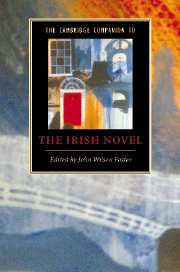Book contents
- Frontmatter
- Introduction
- 1 The novel before 1800
- 2 The national tale and allied genres, 1770s-1840s
- 3 The novel of the big house
- 4 The Gothic novel
- 5 Catholics and fiction during the Union, 1801-1922
- 6 Irish modernisms, 1880-1930
- 7 James Joyce
- 8 Region, realism and reaction, 1922-1972
- 9 The novel in Irish
- 10 Women novelists, 1930s-1960s
- 11 Two post-modern novelists: Samuel Beckett and Flann O’Brien
- 12 Life writing in the twentieth century
- 13 The novel and the Northern Troubles
- 14 Contemporary Irish fiction
- Index
12 - Life writing in the twentieth century
Published online by Cambridge University Press: 28 January 2007
- Frontmatter
- Introduction
- 1 The novel before 1800
- 2 The national tale and allied genres, 1770s-1840s
- 3 The novel of the big house
- 4 The Gothic novel
- 5 Catholics and fiction during the Union, 1801-1922
- 6 Irish modernisms, 1880-1930
- 7 James Joyce
- 8 Region, realism and reaction, 1922-1972
- 9 The novel in Irish
- 10 Women novelists, 1930s-1960s
- 11 Two post-modern novelists: Samuel Beckett and Flann O’Brien
- 12 Life writing in the twentieth century
- 13 The novel and the Northern Troubles
- 14 Contemporary Irish fiction
- Index
Summary
Issues of genre
The novel has always borne a close relationship with the 'literature of fact' - history, travel writing, confession, letters and the diary - and the parallels between fiction and life writing are similarly deep and long-standing. James Joyce chronicles his coming of age in a third-person narration about young Stephen Dedalus, and writers as diverse as Patrick Kavanagh, Mary Costello and Seamus Deane offer as novels thinly disguised versions of their early years. Calling his three-volume autobiography, Hail and Farewell (1911-14), a 'novel about real people', George Moore draws attention to the blurring of genre endemic to life writing, as does Oliver St John Gogarty when he prefaces As I Was Going Down Sackville Street (1937) with the disclaimer, 'The names in this book are real, the characters fictitious.' Yet while autobiographical fiction and the fictionalised autobiography both play fast and loose with facticity, the two genres are not synonymous, and a consideration of their differences elucidates the contributions life writing has made to the development of prose narrative in modern Ireland.
- Type
- Chapter
- Information
- The Cambridge Companion to the Irish Novel , pp. 223 - 237Publisher: Cambridge University PressPrint publication year: 2006
- 1
- Cited by



